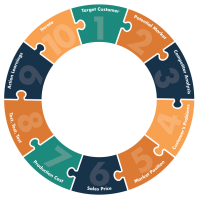How to create your competitive advantage

72% of all new product innovations flop. Make sure you are in the 28% that don’t.
Competitive advantage is created when you understand your customer’s problem(s) in depth and are able to create a solution that solves the customer’s problem more efficiently or better than competitors in the market place.
In what area do you want to compete?
Most entrepreneurs start with a broad area in mind. It could be a new snacking product, or a consultancy business or making a new type of pump.
But when you are starting out you need to narrow down the area you are working on. Focus becomes important as you only have some many resources. You are also unlikely to have a great deal of knowledge about your potential customers.
When the business is more mature, you have more resources and a much better understanding of your customer.
The company with the most insights about its customers usually wins in the competitive market place
Choosing your target customer
This may not be as easy as it sounds if you are entering the market for the first time.
Whether the area in which you are competing is large or small, there are likely to be a number of customer groups within that area. Which one or few groups do you want to go after and why?
Create a profile of your ideal customer. What do they do? What places to they go to? What problems might your customer have (in the space you want to play)?
Does the 80/20 rule apply? Often, 80% of the profits can be made from 20% of the customer base. It may take time to find that segment of the customer base.
If you think this is not likely then look at Apple or Ikea. They both sell to a minority of the available customers yet make the highest margins in their sector. There are many examples of companies of all sizes across many sectors that have created significant competitive advantage by only selling to a small proportion of the potential customer base.
Understanding the customer’s problems
The customer may have one problem but in most cases there are likely to be multiple problems. Finding and then understanding the list of problems is crucial starting point to creating a product or service that answers these problems well.
Think about the different ways of understanding the customer’s problems.
It is far cheaper and quicker to understand the customers problems before you create a product and start selling it. Changing products is more expensive than changing plans.
Choosing which problem to address and why
You should be able to create a list of customer problems. It is probably undesirable for you to try to address more than a few of these problems.
Choose which problems are the most important to the customer to solve. Are these problems also the ones the customer will pay most to solve?
Prioritise your customer’s problem list.
Designing a product or service on paper that solves the problem(s)
Work out which problem(s) you are going to solve and design your solution to solve these ones in the best way you can. Logic would suggest you focus on the problems that are more important to your customers and which are most valuable to them.
Build a product hypothesis (on paper) and test this prior to building actual physical products. If you are a services business, you can test the actual product.
Get out of the office
You are not able to design a great product in the isolation of your office. You must get out of the office and test your product or product hypothesis with potential customers.
This is a really important stage and is likely to result in significant refinement of your product/service. It is much quicker and cheaper to change plans than actual products and services.
Design your tests carefully and assign success factors to your tests prior to you starting them.
Go through this learn and improve cycle as many times as you need to create a great product or service that really solves a few key customer problems.
In summary
Building competitive advantage takes significant effort and time. The marketplace is constantly changing with new entrants, external influences such as economy or regulation – your product has to change with it. If you want to be competitive and remain competitive, you must put the time.






